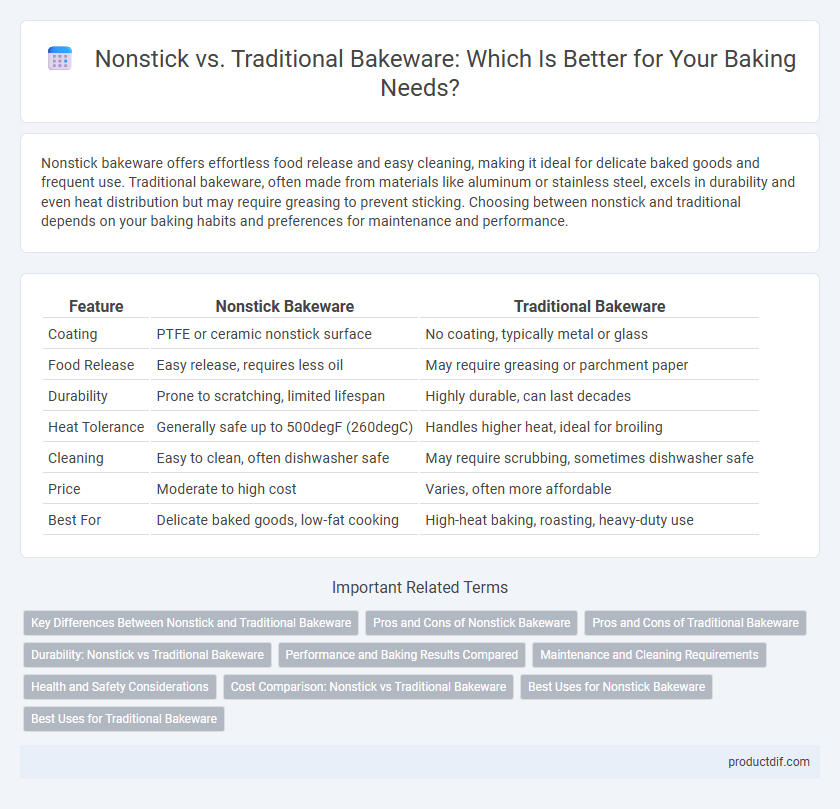Nonstick bakeware offers effortless food release and easy cleaning, making it ideal for delicate baked goods and frequent use. Traditional bakeware, often made from materials like aluminum or stainless steel, excels in durability and even heat distribution but may require greasing to prevent sticking. Choosing between nonstick and traditional depends on your baking habits and preferences for maintenance and performance.
Table of Comparison
| Feature | Nonstick Bakeware | Traditional Bakeware |
|---|---|---|
| Coating | PTFE or ceramic nonstick surface | No coating, typically metal or glass |
| Food Release | Easy release, requires less oil | May require greasing or parchment paper |
| Durability | Prone to scratching, limited lifespan | Highly durable, can last decades |
| Heat Tolerance | Generally safe up to 500degF (260degC) | Handles higher heat, ideal for broiling |
| Cleaning | Easy to clean, often dishwasher safe | May require scrubbing, sometimes dishwasher safe |
| Price | Moderate to high cost | Varies, often more affordable |
| Best For | Delicate baked goods, low-fat cooking | High-heat baking, roasting, heavy-duty use |
Key Differences Between Nonstick and Traditional Bakeware
Nonstick bakeware features a coating that prevents food from sticking, enabling easier release and cleanup, while traditional bakeware relies on proper greasing or lining to avoid adhesion. Nonstick surfaces typically require gentler utensils to prevent scratching, whereas traditional bakeware often offers greater durability and higher heat tolerance. The thermal conductivity varies, with traditional metals like aluminum or stainless steel providing even heat distribution, whereas nonstick pans may have added layers influencing cooking performance.
Pros and Cons of Nonstick Bakeware
Nonstick bakeware offers the advantage of easy food release and quick cleanup, reducing the need for excess oils or greases, which promotes healthier baking. However, nonstick coatings can degrade over time, especially when exposed to high temperatures or metal utensils, potentially releasing harmful chemicals and limiting durability. Traditional bakeware, often made from materials like stainless steel or cast iron, tends to be more durable and versatile but may require greasing and more effort for cleaning.
Pros and Cons of Traditional Bakeware
Traditional bakeware, commonly made from materials like aluminum, stainless steel, and glass, offers excellent heat conduction and durability, making it reliable for even baking results. It often requires greasing or lining to prevent food from sticking, which can add prep time and cleanup effort. While traditional bakeware is versatile and typically dishwasher safe, it may stain or develop odors over time, unlike nonstick options that provide easier food release but may wear out faster.
Durability: Nonstick vs Traditional Bakeware
Nonstick bakeware features a coating that resists food sticking but tends to wear down over time, especially with frequent use or abrasive cleaning, reducing its durability. Traditional bakeware, made from materials like stainless steel or cast iron, offers superior longevity and can withstand high temperatures and rigorous use without compromising performance. Choosing traditional bakeware ensures long-term durability, while nonstick options require more careful maintenance to preserve their coating.
Performance and Baking Results Compared
Nonstick bakeware offers superior food release and easier cleanup, minimizing the need for excessive greasing compared to traditional metal pans. Traditional bakeware, often made from aluminum or stainless steel, provides even heat conduction and a crispier crust, preferred for baking bread or pastries. While nonstick pans excel in preventing sticking, traditional bakeware delivers consistent heat distribution, enhancing browning and texture in baked goods.
Maintenance and Cleaning Requirements
Nonstick bakeware requires minimal effort for cleaning due to its smooth coating that prevents food from sticking, often needing just a gentle wipe with a soft sponge and mild detergent. Traditional bakeware, such as cast iron or stainless steel, demands more intensive maintenance including thorough scrubbing and occasional seasoning to prevent rust and maintain performance. Proper care of both types extends their longevity, but nonstick surfaces are more prone to damage from abrasive materials and high heat.
Health and Safety Considerations
Nonstick bakeware typically features a PTFE coating that prevents food from sticking and reduces the need for excessive oils, supporting healthier cooking methods. Traditional bakeware, often made from materials like aluminum, stainless steel, or cast iron, lacks chemical coatings but may require extra grease to avoid sticking, which can affect calorie content. Health considerations include avoiding overheating nonstick surfaces to prevent toxic fumes, while traditional materials offer durability and non-toxic cooking but may pose risks if not properly maintained to prevent rust or leaching.
Cost Comparison: Nonstick vs Traditional Bakeware
Nonstick bakeware typically costs 20-40% more than traditional options due to advanced coating technology and durability features. Traditional bakeware, often made from aluminum or stainless steel, offers lower upfront prices but may require more frequent replacement or additional oil to prevent sticking. When budgeting for bakeware, factoring in long-term maintenance and replacement expenses highlights the cost-effectiveness of nonstick varieties despite their higher initial investment.
Best Uses for Nonstick Bakeware
Nonstick bakeware excels in recipes requiring delicate handling such as cakes, muffins, and cookies, where easy release prevents damage and ensures even browning. Its smooth coating reduces the need for excessive greasing, promoting healthier baking and effortless cleanup. Ideal for sticky or sugary items like caramel tarts and sticky buns, nonstick surfaces help maintain the shape and texture of baked goods without residue buildup.
Best Uses for Traditional Bakeware
Traditional bakeware, typically made from materials like aluminum, stainless steel, or glass, excels in achieving even heat distribution for consistent baking results. It is best suited for recipes requiring firm crusts and browning, such as cookies, bread, and casseroles, where Maillard reactions enhance flavor and texture. Durable and versatile, traditional bakeware can withstand high oven temperatures and is ideal for roasting and baking dense dishes.
Nonstick vs Traditional Infographic

 productdif.com
productdif.com